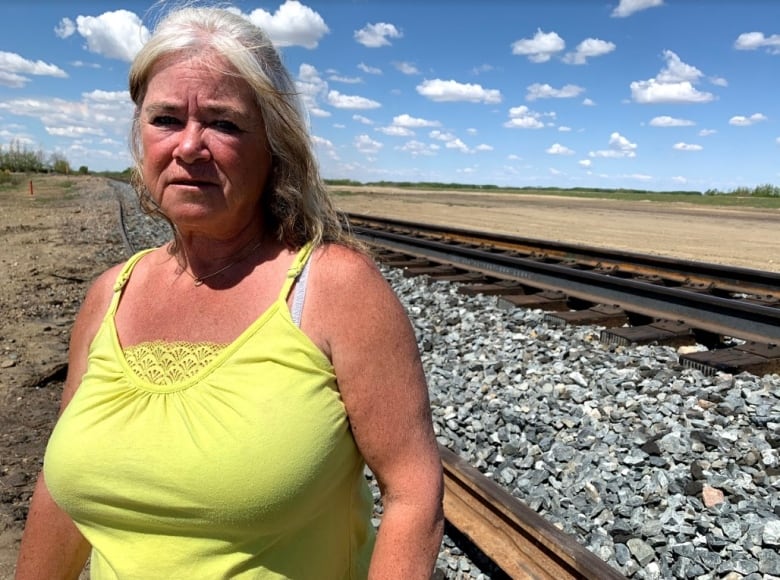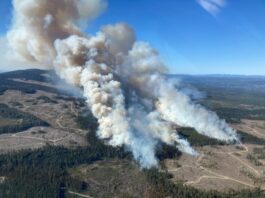
When Melanie Loessl got a call from a friend on Feb. 6 that another oil train had crashed and burned near her community, she thought it was a joke.
Not two months earlier, she’d been forced to flee after a different Canadian Pacific Railway train carrying crude oil jumped the tracks and exploded near her home, just west of the hamlet of Guernsey, Sask.
Now, the entire community was facing evacuation.
“I was just like, ‘Oh, my God. Not again,'” said Loessl, a local potash mine worker.
“Once it happens twice in a row, it’s kind of scary.”

A CBC News investigation has uncovered years’ worth of Transport Canada inspection reports documenting hundreds of safety problems along the Saskatchewan rail line, none of which prompted orders for trains to stop rolling.
What’s more, since the 2013 rail disaster in Lac-Mégantic, Que., that killed 47 people, there have been seven major derailments of crude oil trains in Canada. In each case, investigators blame broken track.
Experts who reviewed the CBC’s findings say the documents suggest the government regulator, Transport Canada, is failing to properly oversee rail companies and ensure the safety of hundreds of communities along the country’s vast rail networks.
‘Neither derailment was a surprise’
CBC News obtained five Transport Canada inspection reports from 2016 to 2020 for the CP line that stretches 183 kilometres from Wynyard, Sask., through Guernsey to Saskatoon, the province’s most populous city.
The reports detail hundreds of problems found by inspectors: 131 “non-compliances” and 215 “concerns,” including missing or defective railway ties (the wooden planks anchoring the track) and broken joint bars (which connect two long pieces of rail).
Ian Naish, a former director of rail investigations for the Transportation Safety Board (TSB), which investigates rail crashes, reviewed the inspection reports for CBC News.
He says the Saskatchewan track was in “really bad shape.”
“That’s an awful lot of non-compliance reports and concerns, and it looked like they were consistent over the three or four years,” Naish said.
“Neither derailment was a surprise at all.”
The government department that regulates and polices rail companies is Transport Canada.
During May and August of 2019, Transport Canada inspectors found more than 200 issues, including a defective piece of rail just hundreds of metres from where the second oil train derailed and blew up near Guernsey.
The documents detail CP’s plans for corrective action. Transport Canada says CP made “all necessary repairs” to defects found in 2019.
CP says its Saskatchewan line “has and will continue to be properly maintained,” noting the company spends hundreds of millions of dollars on annual maintenance.
Track issues ‘all too common,’ government says
While acknowledging “track issues remain an all too common cause of main track derailments,” Transport Canada insists it runs a “robust” oversight program.
“The non-compliances found during the track inspections in May and August 2019 were considered minor as CP Rail was able to mitigate the safety risk by temporarily reducing the maximum allowable speed along the tracks until repairs were made,” a government spokesperson said in an email.
And yet, two trains derailed and exploded on that very track, spilling a combined 3.1 million litres of crude oil and prompting the people of Guernsey to evacuate their homes.
The Transportation Safety Board says it suspects broken rail as the cause of both crashes.

Heavy loads on the rise
Jack Gibney, the reeve for the municipality that includes Guernsey, wonders whether CP shouldn’t have foreseen the track issues, given the dramatic increase in oil shipments.
“The last couple years, it’s probably three times the amount of traffic we’re used to. Trains a mile long,” he said. “You can’t expect to put that much traffic over a rail line and not do the proper upkeep to keep it safe.”
In fact, CP’s loads of crude oil along the line southeast of Saskatoon have increased sevenfold since 2017, according to the Transportation Safety Board.

Rob Johnston, the head of the board’s rail operations for Central Canada, points to two Canadian National Railway oil trains that derailed in early 2015. The crashes happened within 11 kilometres and three weeks of each other near Gogama in northern Ontario.
CN reconstructed large sections of the track to handle heavier loads and hasn’t had a crash there since, Johnston said.
“That speaks volumes to what needs to be done here,” he said of the Saskatchewan track.
In Guernsey, on the heels of this winter’s explosions and spills, CP is now replacing a large span of track. The company says it has also added 11 of its own new inspectors across Canada where crude trains operate.
WATCH | We flew a drone over CP’s repair work in Guernsey:
‘Chronic problems’ met with no sanctions
There have been seven major oil train crashes in Canada since Lac-Mégantic: the two in Guernsey; the two in northern Ontario in 2015; plus one in St. Lazare, Man.; and two more in northwestern Ontario.
No one died, but five of the crashes happened within a few kilometres of towns and villages.
Six of the seven resulted in spills, releasing a combined 8.4 million litres of crude oil.
In all cases, the Transportation Safety Board blames track issues.

Naish says it shouldn’t take so many disasters for the government to act, pointing to the “chronic problems” found on the Saskatchewan line and the lack of fines or train shutdowns ordered by Transport Canada.
“Sometimes regulators have to drop the hammer [on railways],” Naish said.
In Saskatchewan, “there was all kinds of opportunity for regulatory action before the accidents actually occurred,” he said.
‘Tighter controls’ over industry needed, TSB warns
In March, the TSB issued two rail safety advisories warning Transport Canada to overhaul the track safety rules for routes that carry heavy volumes of dangerous goods.
“We’re asking them to put improved standards and maybe tighter controls,” Johnston said.
Transport Canada responded in April by issuing three ministerial orders. They instructed railways to improve the quality and frequency of track inspections.
The federal regulator also called on rail companies to develop and revise new track safety rules.
But that’s a problem, according to Bruce Campbell, a professor of environmental studies at York University who wrote a book on the Lac-Mégantic disaster.
“The government touts its rigorous regulatory practices, but in reality, risk management is left to the companies,” he said. “In an ideal world, Transport Canada would have the science and the resources to independently evaluate and revise the rules itself.”
After the 2013 Lac-Mégantic catastrophe, the government and railways adopted tougher safety measures for shipping dangerous goods, including redesigning oil tanker cars.
Yet derailments and spills keep happening, Campbell said.
“Guernsey dodged a bullet,” he said. “What happens if the next time it’s in a large community like Toronto or Montreal or Vancouver or Winnipeg?
“That’s my worry.”












